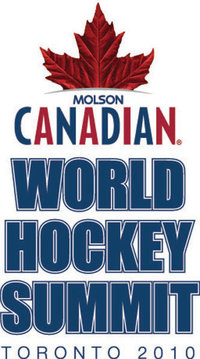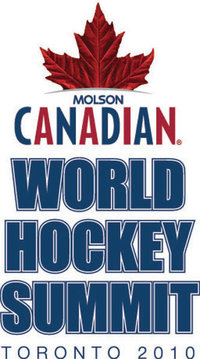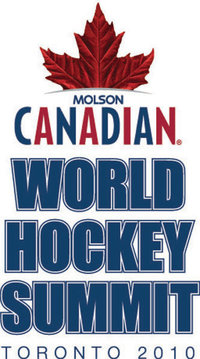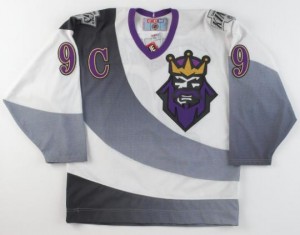World Hockey Summit: Day 3
 Debate over the National Hockey League’s role in international hockey, especially the Winter Olympics, built to a crescendo at the World Hockey Summit yesterday.
Debate over the National Hockey League’s role in international hockey, especially the Winter Olympics, built to a crescendo at the World Hockey Summit yesterday.
International Ice Hockey Federation President Rene Fasel had started thumping the war drums on Tuesday when he warned the NHL that they would expand to Europe “over his dead body”.
During that same question and answer session with TSN’s Gord Miller he called for professional hockey players to play at the 2014 Winter Olympics at Sochi, Russia.
Wednesday morning there was an evaluation of the 2010 Olympics, with Fasel, Vancouver Organizing Committee CEO John Furlong and International OIympic Committee member Timo Lumme speaking about the great success and popularity of hockey at this year's Games.
All three emphasized that the 114 million worldwide viewers of the USA-Canada men’s hockey final had been drawn, in part, by the fact that it was a best-on-best game that featured NHLers.
After the keynotes were done, Miller, acting as moderator, allowed IIHF member Igor Kuperman, sports marketing guru Brian Cooper, Detroit Red Wings general manager Ken Holland, Ottawa Senators captain Daniel Alfredsson and New Jersey Devils captain Jamie Langenbrunner to respond.
Not surprisingly, all five panellists supported the NHL’s return to the Olympics, with only Holland showing any kind of hesitation. The successful GM had many concerns about scheduling and injury issues affecting the success and health of his professional club.
When discussion broke out amongst the hundreds of delegates in attendance, there was an easy consensus that the NHL and Olympics need each other for the fans and the good of the game.
After lunch, NHL Commissioner Gary Bettman had a Q+A with TSN’s Pierre Maguire. During the interview Bettman repeatedly said there were pros and cons to sending his players to Sochi.
“We haven’t said ‘no,’” said Bettman. “And anybody who suggests that we’ve made a decision or suggests I’m anti-Olympics doesn’t get it, because what we’ve been simply saying is, ‘it’s a mixed bag.’”
Bettman stressed that he was commissioner when the NHL first started playing in the Olympics at Nagano, Japan, four cycles ago and that he has always been interested in exposing the sport to as many people as possible.
Many had expected that Bettman’s half-hour session was going to be the most heated event of the day. However, it was the follow-up discussion of a Global Event Agenda that was really contentious.
Moderated by Darren Dreger, the panel began with a thoughtful presentation by Edmonton Oilers associate coach Ralph Krueger, who had served as head coach of the Swiss national team at the Vancouver Olympics.
Krueger proposed a new schedule for international events, featuring the Olympics every four years, a World Hockey Championship during the intervening years and an under-23 world championship during Olympic years.
He also suggested that the Victoria Cup, an annual club championship between two European teams and two NHL teams, should be revived.
Miller then opened the floor to the panel of NHL Deputy Commissioner Bill Daly, Kontinental Hockey League President Alexander Medvedev, Team USA and Toronto Maple Leafs GM Brian Burke, NHL alum Anders Hedberg, former NHL goaltender and prominent NHLPA member Glenn Healy, NHLPA representative Mike Ouellet and IIHF member and broadcaster Paul Romanuk.
Although things began reasonably as each panellist said their piece, Fireworks ensued when they had the chance to rebut each other.
Generally speaking, Burke and Daly presented the case for the NHL staying out of the Olympics, highlighting that it put teams’ assets – the players – at considerable risk of injury. They were also concerned that the interruption in the professional season damaged the momentum of small-market teams.
“The Olympics don’t hurt the Toronto Maple Leafs, it doesn’t hurt our business model,” said Burke, the former GM of the Mighty Ducks. “But in Anaheim it does. In Nashville, it does. In Florida, it does.”
They were opposed by Healy and Ouellet, who as representatives of the players’ association, felt that their constituency should be allowed to play when and where they wanted, and that practically all NHLers would love to play at the Olympics.
Panellists outside of the labour politics of the NHL like Medvedev, Hedberg and Romanuk also chimed in with their concerns, although all three were adamant that the Olympics should be a “best-on-best” tournament.
The debate laid bare many of the tensions at the highest levels of hockey.
Everything from the ongoing labour disputes between the NHL and NHLPA, the lack of communication between the NHL and IIHF, the competing styles and values of European and North American hockey as well as the emergence of the KHL as a threat to NHL supremacy were all on display.
There were many dramatic moments, including Healy wondering aloud why Burke cared so much about when the World Hockey Championships were scheduled, since the Maple Leafs are always available when the tournament begins in April.
Alliances also shifted quickly in the swirling debate. When a doctor from the IIHF spoke from the floor to correct Healy’s impression that the quality of medical care provided at the Olympics is sub-par, the former Toronto goaltender saw his nemesis Burke leap to his defence.
Similarly, when another delegate called out Burke and Daly saying that it was a simple issue and that he was sick of hearing excuses about NHLers playing in the Olympics, Ouellet and Healy both allowed that it was a complex issue.
Burke was the most energetic debater throughout, taking on all comers from the stage and the floor of delegates, although Daly, Ouellet and Healy were very active as well. It was an exciting and intriguing show that had delegates buzzing for the rest of the day.
Today’s topics will be Women’s Hockey in the morning and Growing Participation. It’s hard to imagine that those panels will be nearly as heated, but you never know.
World Hockey Summit: Day 2
 After nine hours of panels, group work, questions and answer periods as well as informal discussions over food, one thing is clear at the 2010 World Hockey Summit: the amateur hockey system has to change.
After nine hours of panels, group work, questions and answer periods as well as informal discussions over food, one thing is clear at the 2010 World Hockey Summit: the amateur hockey system has to change.
Whether it was cautions from Dr. Steve Norris or Dr. Mark Aubry on the overly demanding training in youth hockey during the morning’s Player Skills Development session or the dire warnings of Czech National Program Director Slavomir Lerner of the talent drain from Europe to North America, it was plain as day that things need to change.
Although it’s difficult to sum up nearly six hours of presentations, the general consensus was that minor hockey associations are too focused on turning young players into National Hockey League superstars, sapping the game of its fun and making it excessively dangerous.
As panellist Brendan Shanahan said “How come I don’t hear about kids playing shinny anymore?”
The speakers spoke of multiple concussions to eight and ten year-olds, massive dropout rates in children’s hockey (44% of American hockey players have stopped playing by the age of nine) and a dwindling European junior system robbed of its best talent by the superior Canadian Hockey League.
During question and answer periods as well as in break-out discussion groups the delegates and officials in attendance at the WHS brainstormed ideas that could make amateur hockey fun again for the casual player, while creating a more practical Long Term Athlete Development plan for adolescents and teenagers who want to become professionals.
The idea that was most popular – garnering a round of applause from the Air Canada Centre’s floor when it was suggested – was raising draft eligibility from 18 to 19.
Many groups of delegates had come up with similar concepts including raising the draft age to 20 or forcing players to stay in midget for a minimum of two years and junior for three. A freeze on all international movement at the junior level was also a common theme.
One radical suggestion was to raise draft eligibility to 19, but allow NHL teams to take 18-year-old players at the cost of two draft picks. So a Sidney Crosby-type player would have cost the Pittsburgh Penguins their first and second-round draft picks.
It was an informative and exciting day of hockey talks, and I’d strongly recommend that you follow the above links to see video of the panel discussions. Also, if you want up-to-date quotes from the day’s events follow me on Twitter.
Today’s discussions will start with an evaluation of hockey’s role at the 2010 Vancouver Olympics, then a Q and A with NHL commissioner Gary Bettman and then finish off with an afternoon session on Establishing a Long-Term Global Event Agenda.
World Hockey Summit: Day 1
 As I mentioned on my Twitter feed, I will be attending the 2010 World Hockey Summit this week, with lots of LiveTweeting on my feed and daily blog posts summarizing what I’ve learned.
As I mentioned on my Twitter feed, I will be attending the 2010 World Hockey Summit this week, with lots of LiveTweeting on my feed and daily blog posts summarizing what I’ve learned.
Hockey Canada is organizing the conference, bringing together hockey organizers, players and coaches from around the world to discuss the future of the game and improve on safety.
In the words of Hockey Canada President Bob Nicholson, the Summit will “provide an inclusive forum to table the most pressing questions surrounding our game and work together to find implementable solutions.”
Day 1 was very straightforward. It was basically clear from nine until five, giving all the attendees a chance to register and settle into their accommodations in downtown Toronto.
Tonight there will be a Hot Stove Session at the Hockey Hall of Fame where four panels rotate from room to room, discussing Contracts and Transfers, Agents’ Role in Working with Young Players, State of the Game and Comparisons of the International and North American Game.
Unfortunately, I’ve got previous commitments for tonight, so I’ll be missing out on those talks. They do sound very interesting though, and I’ll try to get my hands on a recap of the discussions to share here.
Tomorrow will start with a continental breakfast at the Air Canada Centre, home of the Toronto Maple Leafs and the National Hockey League’s Canadian office. There’ll then be a three hour session on Player Skills Development.
At one in the afternoon, Rene Fasel, the President of the International Ice Hockey Federation, is going to have a half-hour Q+A period.
Next up is the session that I am most interested in: Junior Development in the Hockey World. The reason is fairly obvious – as junior hockey editorial assistant for the Canadian Press, this is my wheelhouse.
It’s going to be a lot of fun and interesting week. Please, check back here tomorrow night or my Twitter feed throughout the day to see what it’s all about.
Follow Friday: Third String Goalie
 As you can undoubtedly tell from this website, I spend a lot of time cruising the Internet. It’s a big part of my job and also a nice way to spend an afternoon. In the fine tradition of Twitter I figured I’d start using Fridays to spotlight websites or podcasts that I enjoy visiting.
As you can undoubtedly tell from this website, I spend a lot of time cruising the Internet. It’s a big part of my job and also a nice way to spend an afternoon. In the fine tradition of Twitter I figured I’d start using Fridays to spotlight websites or podcasts that I enjoy visiting.
One of my favourite blogs to check in on is Third String Goalie. The format is simple. Each day, Jeff chooses a hockey jersey from his immense collection and explains the history of the sweater. Not his personal history with the shirt, but the career of the player, the history of the team and the events that were important to the jerseys’ era.
For example, in a run up to the Olympic games Jeff has been looking at team jerseys from international competition. On Thursday he wrote about his 1998 Czech Republic Dominik Hasek jersey from the Nagano games.
Jeff outlines the history of the Czech team and then goes on to explain how they fared in the 1998 tournament. Then comes the multimedia portion where he has photos of the 1998 jersey, the designs for the 2010 Czech jersey and video of the fateful shootout between Canada and the Czech Republic where Marc Crawford inexplicably kept Wayne Gretzky and Steve Yzerman on the bench.
Every article is filled with exhaustive research and funny asides. Fortunately for the reader, Jeff is a freelance photographer, a career the affords him the time and energy to pour himself into each of these pieces daily.
That's right, you can see brand new material every day of the week. Incredible! You can also follow him on Twitter.
It’s one of my favourite reads, and Jeff was kind enough to submit himself to an email interview.
JCH - How did you get started? Where did you get the idea for Third String Goalie?
I got started doing the blog because I participate in a message board called JerseyCentral.org. On the message board is a thread entitled "What are you wearing today?" It's a place on the board to show off a jersey that is separate from the "new arrivals" thread.
I found myself posting jerseys because of a significant game being played that day or an anniversary of something noteworthy, such as the anniversary of the Miracle on Ice. My explanations were getting a bit longer each time and I realized I had even more information to share than I was posting.
In addition, I have a pretty sizable collection and a desire to share it with people beyond just posting pictures of them. I wanted to explain the significance of why I recreated that specific jersey, as most of my jerseys have some sort of story to tell.
Since just having pictures of them online wasn't satisfying and I didn't want to hijack the message board thread with overly long stories, it occurred to me that a blog was the way to go.
Even before I started the blog, I had the name filed away, having come across it while reading an article in an old issue of Baseball Digest from 1956 that was a humorous glossary of terms. One of the entries was "Third String Catcher", which meant a fan in the stands wearing a jersey. First, I thought "Well, that pretty much describes me." and thought it would be a great name for a website. When I started the hockey blog, I just changed it to "Third String Goalie".
JCH -You've been blogging since May and have over 280 posts, averaging more than one post per day. How do you keep up that pace?
The combination of being freelance and the economy being lousy has give me a lot of free time. Blogging is a great way to escape reality! I do most of my writing after my son goes to bed in the evening.
JCH - What was your first hockey jersey?
My first jersey was a white Minnesota North Stars jersey from the early 80's. I bought from the team souvenir stand. It was out of stock and took forever to arrive.
JCH - What is your favourite jersey?
Hard to pick just one, but my favorite is my early 90's Soviet Red Army jersey. It's such an icon with the hammer and sickle logos, stars and name on the back in Cyrillic.
JCH - What do you look for in a jersey?
I've always liked a jersey that tells a story of some sort. Any jersey that you can put an extra patch on is desirable in my book, be it an anniversary, memorial, Stanley Cup Finals or tournament patch.
I've bought jerseys because they used a cool font for the numbers, because they came up with a great looking design, because they came up with a horrible design, because it was a jersey of a favorite player or represents a significant occurrence, like the 1972 Summit Series.
JCH - What's the ugliest jersey you've ever seen? The nicest?
The ugliest in my book is the 1995-96 Mighty Ducks of Anaheim alternate "Wild Wing" jersey. While the Los Angeles Kings 95-96 alternate "Burger King" jersey is really weird and the Dallas Stars "Mooteurs" is mind-numbingly ugly and dumb, the "Wild Wing" lacks any dignity at all. It just reeks of being designed by people with no appreciation for NHL hockey and I can't believe they even asked NHL players to wear it. Of those three, it's the only one that's so stupid that it makes me mad just thinking about it. Of course, I own two of them!
The nicest. I really liked the Dallas Stars green and black jerseys with the star pattern first used as an alternate in 1997-98 that they won the Stanley Cup in. That was such a nice looking jersey when it first came out I was able to overlook the fact that it was my old North Stars team that was stolen from me wearing it and knew immediately I needed to buy one.
I also like the classic Boston Bruins jerseys worn from the mid 70's to the mid 90's.
JCH - On your blog you advise your readers to "never, ever tuck your jersey into your pants." Any other sweater faux-pas you want to speak out against?
I'm not a fan of putting you own name and number on a jersey, but can understand the reasoning why people do it. Those people are not the ones sitting there with Thrashers Kovalchuk or Wild Gaborik jerseys today. There's no hope of any resale value in putting your own name on the back, but many people don't plan on selling theirs.
The thing that's really starting to annoy me is the number of people who could care less that they have bought a horrible, horrible Chinese knockoff. There are some that are just dreadful. I once saw a vintage Washington Capitals Alexander Ovechkin jersey were all the red parts were orange. ORANGE! The fonts were off, the colors were off, Ovechkin never wore that style. Have some pride, man.
That said, the copies are getting much better and if Reebok hadn't jacked up the price on the new, ill-fitting edge jerseys (where if the body fits, the arms are way too long) by a good 50% to $120 over the wonderful CCM 550's that were $80 AND cheapened the jerseys at the same time with screen printed, brittle shoulder patches and screen printed numbers made to look like quality sewn numbers, there wouldn't be such a market for a lower priced alternative now, would there?
JCH - How do you do all that research for each blog post?
The Internets. It's all out there waiting to be found. I do have a library of hockey books to fall back on, but most of it comes from an assortment of websites I rely on like IIHF.com. One place I go out of my way not to use are other blogs. I don't want to come across as having copied their work. Perhaps we will arrive at a similar story, having found the same information, but I do find my information on my own.
I do have to go out of my way to mention NHLUniforms.com. I bet I have visited that site every day for the last eight years.
JCH - I was most impressed with your Jan. 29 post on Bob Sauve's Buffalo Sabres jersey. How did you ever get all that detail on the players' experiences combating the blizzard?
I got lucky and found an article on SIVault.com that had the quotes in it. I don't use that site as much as I should, as I often find their information concerning factual things differs at times from other websites. For example, the number of Sabres players they listed having made the plane trip to Montreal was different that other sites. Perhaps SI originally stated "Don Luce arrived at the airport and he and 14 others made the trip". Other websites will take that and repeat is as "14 players made the trip". I assume that an article written in February 1977 based on first hand interviews with the participants will be more accurate than one created in 2007 with second and third hand information.
It's funny how often I find conflicting information. I've seen Clint Benedict credited with wearing the first goalie mask for just one, four and five games on different websites.
JCH - What are you most proud of on your blog?
That I have stuck with the idea, that my work has gotten recognized somewhat and that I've tried to bring enough variety to my topics that it will catch people off guard from time to time. Like the blizzard story for example, or the one where I discovered that the entire reason the NHL was formed in 1917 was for the four owners to rid themselves of a fifth owner from their previous league who they couldn't stand!
JCH - What do you hope your readers get out of Third String Goalie?
An appreciation for a cool looking jersey, an appreciation for a player they may not have known much about before, like Stan Mikita, an appreciation for hockey beyond the NHL, especially international hockey with the Olympics on the horizon, and an appreciation for hockey prior to Wayne Gretzky.
The NHL didn't start with Gretzky and has over sixty years of history to tell that many people are not aware of. Heck, the Stanley Cup was around a quarter of a century before the NHL even came to be. Most people have no idea that is the case.
It's my hope that each day a number of people think "Well I didn't know that before" or are reminded of something from the past they hadn't thought of in a while.
JCH - And finally... How can we get more Marie-Pier on Third String Goalie?
If I ever do a story on the Montreal Canadiens, I see if she's got any relevant videos available. More Habs equals more Marie-Pier, even if I can't understand a single thing she's said.
I try not to be too English-centric and have no fear posting videos in Latvian, Finnish, Russian, Swedish or French. I've had readers from 86 different countries, so it's nice to make them feel at home from time to time. There's something universal about an excited announcer screaming his head in Czech off after a goal that we can all understand and appreciate.
